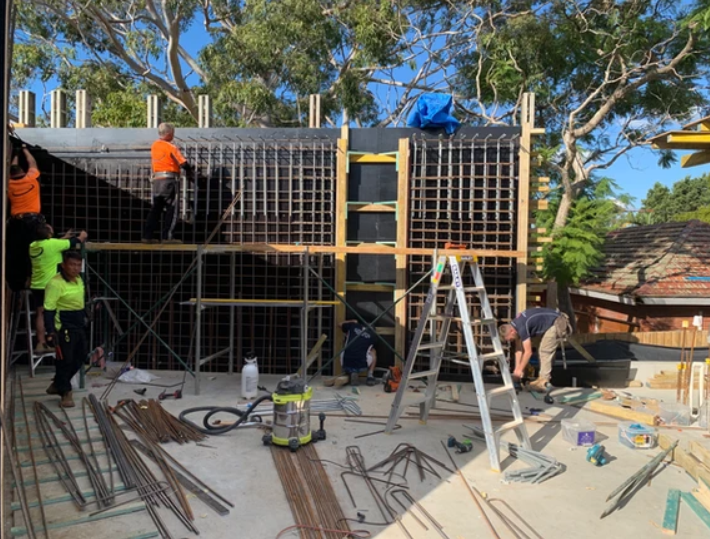Concrete formwork plays a critical role in shaping and supporting fresh concrete until it hardens and gains sufficient strength. The performance and design of formwork, however, can be significantly influenced by external factors such as temperature and humidity. These environmental conditions not only affect the curing process of concrete but also impact the materials used in formwork and the overall efficiency of construction.
It is worth exploring how temperature and humidity influence the performance and design of concrete formwork, with a focus on pouring concrete in different climatic conditions, the specific challenges faced by contractors, and the role of formwork design in mitigating these challenges. Through a case study, we’ll shed light on how a new formwork design can help increase productivity and performance on a construction site, demonstrating the importance of considering environmental factors in concreting projects.
The Basics of Concrete Formwork
Concrete formwork is a temporary structure that holds fresh concrete in place while it sets and hardens. The formwork can be made from various materials, such as plywood, steel, or plastic, depending on the project requirements. It must be sturdy enough to withstand the weight of the wet concrete, yet flexible enough to be easily removed once the concrete has cured.
However, while the materials and design of formwork are essential, the conditions under which the concrete is poured—specifically temperature and humidity—play an equally significant role in determining the success of the project. These environmental factors directly affect the curing process of the concrete, which in turn impacts the integrity of the final structure.
How Temperature Affects Concrete Formwork and Curing
Temperature has a profound impact on both the performance of formwork and the curing process of concrete. When pouring concrete, contractors must carefully consider the ambient temperature to ensure optimal results. Let’s look at how different temperatures affect the process:
1. High Temperatures
In high-temperature environments, the primary concern is the accelerated curing process of concrete. Concrete generates heat as it cures, and in hot climates, this heat can cause the water within the mix to evaporate too quickly. Rapid evaporation can lead to shrinkage cracks, reduced strength, and compromised durability. Moreover, high temperatures can make it challenging to manage the formwork because the concrete hardens faster, reducing the window for adjustments and finishing.
High temperatures also affect formworking materials, particularly when using formwork ply. Plywood can expand or warp under extreme heat, leading to misalignments in the formwork structure, which can result in imperfections in the concrete surface. Additionally, excessive heat can degrade the adhesives used in some types of formwork, reducing their durability and requiring frequent replacements.
To mitigate the effects of high temperatures, contractors often use cooling techniques, such as misting the concrete or adding water-retentive curing blankets. In some cases, advanced formwork designs incorporating insulation materials can be used to regulate temperature and slow down the curing process.
2. Low Temperatures
Conversely, low temperatures slow down the curing process of concrete. When temperatures drop below freezing, there’s a risk that the water in the concrete mixture will freeze before it has a chance to properly cure. This can result in a weaker concrete structure that is more prone to cracks and other structural issues. Cold weather also affects the materials used in formworking, causing some to become brittle or difficult to work with.
To address these challenges, contractors working in cold climates may use heated formwork, thermal blankets, or even mix additives into the concrete to accelerate curing. They must also be mindful of timing, as the extended curing time can delay the overall project. Proper formwork design in cold climates should account for these extended curing times and ensure the formwork provides adequate protection against freezing.
How Humidity Affects Concrete Formwork
Humidity, like temperature, has a significant effect on concrete curing and the performance of formwork. The amount of moisture in the air directly impacts how much water evaporates from the concrete, which can either hasten or delay the curing process.
1. High Humidity
High humidity levels can slow the evaporation of water from the concrete mix, which helps reduce the risk of shrinkage and cracking. While this can be beneficial in preventing premature drying, it can also extend the curing time, leading to delays in the construction schedule. In particularly humid environments, the extra moisture can cause issues with the formwork materials, especially when using wooden forms, as they can absorb the moisture and become deformed or warped.
The use of steel or plastic formwork in high-humidity environments is often recommended to prevent moisture absorption. Additionally, contractors may apply a release agent to the formwork to make removal easier and to avoid the formwork sticking to the concrete surface once it has cured.
2. Low Humidity
In dry, low-humidity conditions, evaporation from the concrete occurs much faster, which can lead to issues similar to those seen in high-temperature environments. The rapid loss of moisture can result in shrinkage cracks, decreased surface strength, and a higher risk of dusting (where the concrete surface becomes powdery).
To prevent these issues, contractors often employ curing techniques such as misting or covering the concrete with plastic sheets to retain moisture. Furthermore, in low-humidity environments, formwork designed with moisture-retention properties can play a crucial role in preserving the integrity of the concrete during curing.
The Role of Formwork Design in Addressing Environmental Factors
Formwork design plays a vital role in compensating for the effects of temperature and humidity on the concrete curing process. Modern formworking solutions incorporate advanced materials and designs that are better suited to handle the stresses imposed by various environmental conditions.
One of the most important aspects of formwork design is adaptability. Contractors are now using formwork systems that can be easily adjusted or modified to suit the specific conditions of a project site. For example, formwork with built-in insulation can be used in cold climates to retain heat and prevent freezing. Similarly, formwork with integrated ventilation systems can help reduce heat buildup in hot climates, ensuring a more consistent curing process.
Case Study: Productivity Boost Through Advanced Formwork Design
A notable example of how advanced formwork design can overcome environmental challenges comes from a large-scale commercial project in Sydney. The project involved pouring concrete for a multi-story office building during the height of summer, with daily temperatures exceeding 35°C (95°F). The high temperatures presented significant challenges for the project team, who were concerned about rapid evaporation of water from the concrete, potential shrinkage cracks, and reduced workability of the concrete mix.
The construction team partnered with a local provider of formworking solutions, utilising a new type of modular formwork system specifically designed for high-temperature environments. This system featured built-in insulation layers that helped regulate the temperature of the concrete during curing. The insulated formwork reduced the rate of water evaporation and kept the concrete from setting too quickly, giving the team more time for finishing work and reducing the risk of cracks.
Additionally, the project used concrete with pumps to pour the concrete into the formwork, which allowed for precise and efficient placement of the material, even in hard-to-reach areas. The combination of advanced formwork design and the use of concrete pumps not only improved the quality of the final structure but also significantly increased productivity on-site. The project was completed ahead of schedule, with minimal delays caused by the extreme heat, thanks to the innovative approach to formwork.
What Makes a Successful Concrete Formwork
Temperature and humidity are critical factors that influence the performance and design of concrete formwork. High temperatures can accelerate the curing process, leading to shrinkage and cracking, while low temperatures can slow down curing, potentially compromising the structural integrity of the concrete. Similarly, humidity levels affect moisture retention in concrete, with high humidity slowing down curing and low humidity speeding it up.
Modern formworking solutions have evolved to address these environmental challenges, with advanced designs that incorporate insulation, moisture control, and adaptable systems that can be modified to suit different climatic conditions. The case study of the Sydney project highlights how innovative formwork design can not only overcome environmental challenges but also boost productivity and performance on construction sites.
As construction continues to advance, particularly in regions where environmental conditions are a constant concern, the integration of new formwork technologies will become even more essential. By understanding how temperature and humidity affect concreting formwork, contractors can better plan and execute their projects, ensuring both structural integrity and efficiency.





